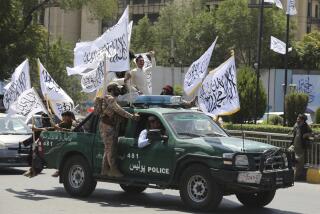Inner Mullah? ‘Yo’ Momma!’ Covered Women Might Say
- Share via
Unlike many foreign journalists, Cara Anna has found insight into the complex and often contradictory nature of Pakistani society. I don’t, however, agree with all her conclusions. As a Pakistani woman and journalist, I agree that the political mind-set of some people in my country needs to change. But it’s not an “inner mullah” that dictates women’s behavior in Pakistan. It’s culture, actually. And trying to change the fundamentals of my nation’s culture is a bad idea for several reasons.
For the majority of Pakistani women, the dress-code equation is simple: If you are covered, you conform, and conformity allows you more opportunity -- to push for social change or simply earn a livelihood.
Seventy-nine percent of female workers in Pakistan work in the fields, concealed by their clothing. No one pays attention. And the women running in that mini-marathon with “their hair loose, and their bosoms ... bouncing” were disdained by many Pakistanis -- not just the mullahs.
Indeed, God and Islam are secondary reasons for concealment. Most Pakistani women cover themselves because it is their culture. For most Pakistanis -- men and women -- “the ancient twin virtues of honor and concealment” are the cultural character and identity they prefer, even today.
This culture predates Islam’s arrival in the Indian subcontinent. Over thousands of years, all parts of Pakistan have adopted it in various hues. Frontier women may like to cover themselves from head to feet in an all-encompassing chador (long, loose head scarf) but women in the southern coastal province of Sindh are content with the baggy shalwar qameez (tunic and loose pants) that covers their bodies no less fully.
Between themselves, women from Peshawar, Karachi and Lahore would argue with and criticize each other on the degrees of their respective concealments, but few would challenge the idea of hiding their flesh.
Anna would do well to understand that there is a difference between “the challenge of changing the mind of the average Pakistani” on politics and changing her mind on culture. To encourage these women to fight for their rights is one thing, and how to go about it is another. I agree that running on streets may not be the answer because it gives ammunition to the mullahs who are trying to monopolize that social asset most dear to all Pakistanis: culture.
I know the value of concealment and I respect it for its (believe it or not) practicality. It gives me an “honorable” opportunity to sit with mullah friends and debate the good and bad things about the war on terrorism, about local government and about women’s rights in Pakistan. I even win some of those arguments, and forge a functional understanding with my religious friends that allows us to exchange views and information that we think can help the average Pakistani.
Whether my Western education agrees or not, I have to respect the fact that the majority of the people in that part of the world would like to keep this culture of physical concealment -- mullahs or no mullahs, rights or no rights.
Few know that the party of the mullahs has a vociferous women’s wing that works methodically to spread the party ideology. Covered in traditional Islamic clothes, they do not hesitate to lead anti-American rallies on Pakistani streets.
They have few followers -- putting Islam before all else is not exactly popular politics in Pakistan. But because these women conform with their culture by covering themselves and walking, people listen to their message.
If they were running in heels, they’d be scorned.
More to Read
Sign up for Essential California
The most important California stories and recommendations in your inbox every morning.
You may occasionally receive promotional content from the Los Angeles Times.










